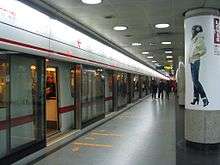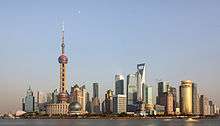Public transport in Shanghai
Shanghai has an extensive public transport system, largely based on buses, trolley buses, taxis, and a rapidly expanding metro system. Shanghai has invested heavily in public transportation before and after the 2010 World Expo, including the construction of the Hongqiao Transportation Hub of high-speed rail, air, metro and bus routes. [1]
All public transport can be paid for using the contactless Shanghai Public Transportation Card.
Shanghai Metro

As of May 2015, the Shanghai Metro rapid-transit system and elevated light metro has 14 lines (numbers 1, 2, 3, 4, 5, 6, 7, 8, 9, 10, 11, 12, 13, and 16) and extends to every core urban district as well as neighbouring suburban districts such as Songjiang and Minhang. Several other lines are under construction. It is the longest metro system in the world with 548 km of track.[2] The first line opened in 1993.[3]
Tram
Trams in Shanghai originally closed in 1963, but a modern tram line opened in 2010: Zhangjiang Tram.
Bus
Shanghai has one of the world's most extensive bus systems with nearly one thousand bus lines, operated by numerous transportation companies. Not all of Shanghai's bus routes are numbered - some have names exclusively in Chinese.[4] Bus fares are usually ¥1, ¥1.5 or ¥2, sometimes higher, while Metro fares run from ¥3 to ¥11 depending on distance.
Trolleybus
Shanghai has the world's oldest continually operating trolley bus system. All trolley buses operate on select routes numbered under 30. All trolleybuses are now air-conditioned.
Taxi
Taxi fare is regulated by Shanghai Government at rate ¥2.40/km or ¥3.10/km after 23:00. (¥14.00 for the first 3 km, ¥18.00 after 23:00).
Maglev

The Shanghai Maglev Train, first commercial Maglev railway in the world, was constructed by Transrapid of Germany in cooperation with the Shanghai municipality and the Shanghai Maglev Transportation Development Co (SMT). The route runs from Shanghai's Longyang Road subway station in Pudong to Pudong International Airport. Commercial operation started in 2003. The 30 km trip takes 7 minutes and 21 seconds and reaches a maximum speed of 431 km/h (267.8 mph). Normal operating speeds usually reach 431 km/h, but during a test run, the Maglev has been shown to reach a top speed of 501 km/h.
Rail
Two railways intersect in Shanghai: Jinghu Railway (Beijing–Shanghai) Railway passing through Nanjing, and Huhang Railway (Shanghai–Hangzhou). Shanghai is served by three main railway stations, Shanghai Railway Station, Shanghai South Railway Station and Shanghai Hongqiao Railway Station. The high-speed railway to Beijing opened in 2011.
References
- ↑ Knight Frank China Knight Frank China Research, Shanghai Annual Industrial Market Report 2009
- ↑ http://www.shmetro.com/node49/201412/con113908.htm
- ↑ "Shanghai Subway - Metro". UrbanRail.Net. Retrieved 2008-05-15.
- ↑ "Personal Cars and China (2003)".
External links
- Shanghai: Status and Trends in the Urban Public Transport
- Development of a rail-based mass rapid transport system in Shanghai
